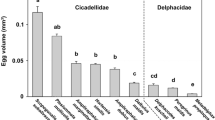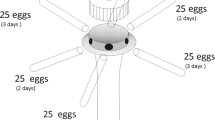Abstract
This study aimed to evaluate the influence of Spartocera dentiventris (Berg) (Hemiptera: Coreidae) egg quality (regarding age, size and superparasitism) on male and female body size of Gryon gallardoi Brèthes (Hymenoptera: Scelionidae). It was also analysed host size influence on offspring sex choice and female oviposition order (within egg groups). Groups of 12 eggs, 2, 3, 4, 5, 6, 7, 8, and 12 days old were individually exposed to a female parasitoid for 2 h, and the order of each egg parasitisation was recorded. Size of adult parasitoids (head width and tibia length of the second leg pair), and parasitised and superparasitised host eggs were measured. Sexual dimorphism related to size (SDs), was estimated through a model II linear regression. Females have a larger head width but a smaller tibia length. Parasitoid adult size is significantly related to host age and size. Within an egg group, females did not exhibit preference for any egg size category either to start oviposition or to oviposit male or female eggs. The body size of both sexes diminished with host aging. There was a positive response in both sexes to host size increasing. Estimated SDs diminished with host aging and increased with host volume augmentation. The results suggest that adult body size of G. gallardoi, as well as size differences between males and females, are strongly associated to host quality.
Similar content being viewed by others
References
Alphen J.J.M. van and Vet L., (1986). An evolutionary approach to host finding selection. In: Waage J.K. and Greathead D.J. (eds). Insects Parasitoids: 13 th Symposium of the Royal Entomological Society of London. Academic Press, Orlando, pp. 23–54
Arakawa R., Miura M. and Fujita M. (2004). Effects of host species on the body size, fecundity, and longevity of Trissolcus mitsukurii (Hymenoptera: Scelionidae), a solitary egg parasitoid of stink bugs. Appl. Entomol. Zool. 39:177–181
Bai B., Luck R.F., Forster L., Stephens B., Janssen J.A.M. (1992). The effect of host size on quality attributes of the egg parasitoid, Trichogramma pretiosum. Entomol. Exp. Appl. 64:37–48
Charnov L. and Skinner S.W., (1985). Complementary approaches to the understanding of parasitoid ovipositor decision. Environ. Entomol. 14:383–391
Eijs I.E.M. and van Alphen J.J.M. (1999). Life history correlations: why are hymenopteran parasitoids an exception? Ecol. Lett. 2:27–35
Ellers J. and Jervis M. (2003). Body size and the timing of egg production in parasitoid wasps. Oikos 102:164–172
Godfray H.C.J., (1994). Parasitoids: Behavioral and Evolutionary Ecology. Princeton University Press, Princeton, New Jersey
Greenberg S.M., Nordlund D.A. and Wu Z. (1998). Influence of rearing host and adult size end ovipositional behaviour of mass produced female Trichogramma minutum Riley Trichogramma pretiosum Riley (Hymenoptera: Trichogrammatidae). Biol. Control 11:43–48
Harvey J.A. and Strand M.R. (2003). Sexual size and development time dimorphism in a parasitoid wasp: an exception to the rule? Eur. J. Entomol. 100:485–492
Izumi S., Yano K., Yamanomoto Y. and Takahashi Y. (1994). Yolk proteins from insect eggs: structure, biosynthesis and programmed degradation during embryogenesis. J. Insect Physiol. 40:735–746
Jervis M.A. and Copland M.J.W. (1996). The life cycle. In: Jervis M.A. and Kidd N. (eds). Insect Natural Enemies: Practical Approaches to their Study and Evaluation. Chapman and Hall, London, pp. 63–190
Jervis M.A., Ferns P.N. and Heimpel G., (2003). Body size and timing of egg production in parasitoid wasps: a comparative analysis. Funct. Ecol. 17:375–383
Johnson N.F., Rawlins J. and Pavuk D.M. (1987). Host-related antennal variation in the polyphagous egg parasite Telenomus alsophilae (Hymenoptera: Scelionidae). Syst. Entomol. 12:437–447
Kraaijeveld A.R., Adriaanse I.C.T. and van den Bergh B. (1999) Parasitoid size as a function of host sex: potential for different sex allocation strategies. Entomol. Exp. Appl. 92:289–294
La Barbera M., (1989). Analyzing body size as a factor in ecology and evolution. Ann. Rev. Ecol. Syst. 20:97–117
Mackauer M., (1996). Sexual size dimorphism in solitary parasitoid wasps: influence of host quality. Oikos 76:265–272
Mackauer M. and Sequeira R. (1993). Patterns of development in insect parasites. In: Beckage N.E., Thompson S.N. and Federicci B.A. (eds). Parasites and Pathogens of Insects, vol. 1, Academic Press Inc., San Diego, pp.1–23
Mayhew P.J. and Glaizot O. (2001). Integrating theory of clutch size and body size evolution for parasitoids. Oikos 92:372–376
Quicke D.L.J. (1997). Parasitic Wasps. Chapman and Hall, London
Rivero A. and West A.S. (2002). The physiological costs of being small in a parasitic wasp. Evol. Eco. Res. 4:407–420
Sagarra L.A., Vincent C. and Stewart R.K. (2001). Body size an indicator of parasitoid quality in male and female Anagyrus kamali (Hymenoptera: Encyrtidae). Bull. Entomol. Res. 91:363–367
SAS Institute Inc. (1990). SAS/STAT Users Guide, Release 6.12 Edition. SAS Institute Inc., Cary, North Carolina
Sousa J.M., Spence J.R. (2001). Host age and parasitism by Thiphodytes gerriphagus (Hymenoptera: Scelionidae), an egg parasitoid of water striders (Heteroptera: Gerridae). Ann. Entomol. Soc. Am. 94:681–685
Strand M.R. (1986). The physiological interactions of parasitoids with their host and their influence on reproductive strategies. In: Waage J.K. and Greathead D.J. (eds). Insects Parasitoids: 13th Symposium of the Royal Entomological Society of London. Academic Press, Orlando, pp. 97–129
Teder T. and Tammaru T. (2005). Sexual size dimorphism within species increases with body size in insects. Oikos 108:321–334
Thompson S.N. (1993). Redirection of host metabolism and affects on parasite nutrition. In: Beckage N.E., Thompson S.N. and Federicci B.A. (eds). Parasites and Pathogens of Insects, vol. 1, Academic Press Inc., San Diego, pp. 125–144
Vinson S.B. (1998). The general host selection behaviour of parasitoid hymenoptera and a comparison of initial strategies utilized by larvaphagous and oophagous species. Biol. Control 11:9–96
Vinson S.B. and Iwantsch G.F. (1980). Host suitability for insect parasitoids. Ann. Rev. Entomol. 25:397–419
West S.A., Flanagan K.E. and Godfray H.C.J. (1996). The relationship between parasitoid size and fitness in the field, a study of Achrysocharoides zwoelferi (Hymenoptera: Eulophidae). J. Anim. Ecol. 65:631–639
Wiedemann L.M., Canto-Silva C.R., Romanowski H.P., Redaelli L.R. (2003). Oviposition behaviour of Gryon galardoii (Hym.: Scelionidae) in eggs of Spartocera dentiventris (Hem.: Coreidae). Bra. J. Biol. 63:133–139
Acknowledgements
To Conselho Nacional de Desenvolvimento Científico e Tecnológico (CNPq) for financial support (Process n.47057/2001-2) and fellowships conceded to first and last authors. The authors are grateful to Dra. Lúcia Maria Guedes Diefenbach for help with the English version of the manuscript.
Author information
Authors and Affiliations
Corresponding author
Rights and permissions
About this article
Cite this article
da Rocha, L., Kolberg, R., de Mendonça, M.S. et al. Body size variation in Gryon gallardoi related to age and size of the host. BioControl 52, 161–173 (2007). https://doi.org/10.1007/s10526-006-9024-6
Received:
Accepted:
Published:
Issue Date:
DOI: https://doi.org/10.1007/s10526-006-9024-6




